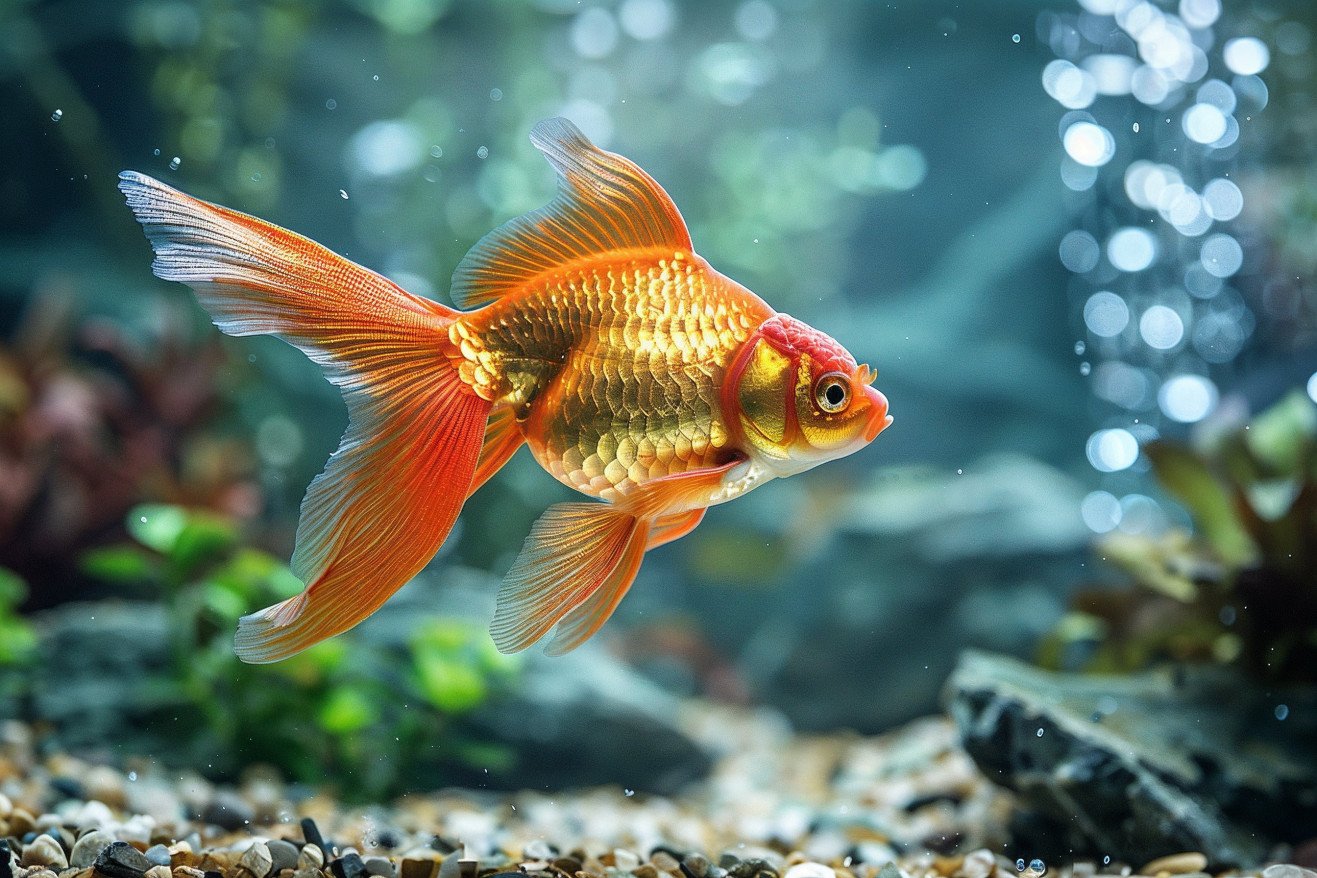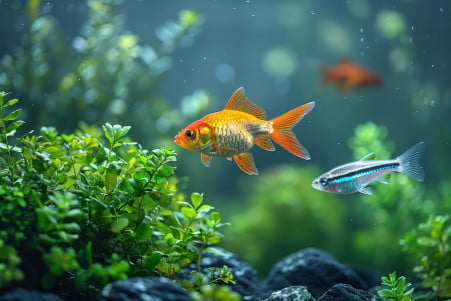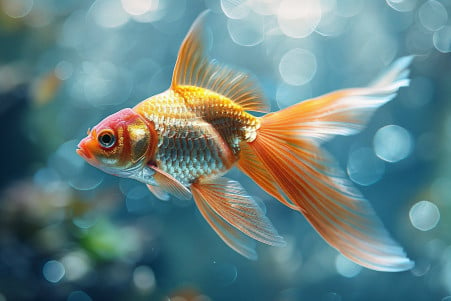Do Goldfish Need a Filter? Essential Aquarium Care Explained
4 March 2024 • Updated 2 March 2024

While it may be easy to understand the basic needs of a goldfish’s environment, one question that many people have is, do goldfish need a filter? The short answer is, yes, goldfish need a filter in their tank.
Filters are essential for removing waste, balancing water parameters, and providing oxygenation. Without a filter, ammonia levels can rise to dangerous levels, which can be harmful to goldfish. Therefore, a filter is necessary to ensure that the goldfish’s environment is safe and healthy.
In this comprehensive review, we will take a deep dive into aquatic biology research, veterinary perspectives, and best practices in fishkeeping to determine the needs of goldfish in captivity. We will look at the impact of filters on water quality, the physiological impact on goldfish when they don’t have proper filtration, and discuss other ways to keep a tank healthy.
By the end of this review, we hope to give you a well-rounded view of the symbiotic relationship between goldfish and their underwater world.
Do goldfish need a filter?
Why Goldfish Need Clean Water to Thrive
Goldfish health is closely tied to the quality of their environment. Water quality factors like ammonia, nitrite, and nitrate levels are important to goldfish health.
For example, the RSPCA Knowledgebase explains that goldfish excrete a lot of waste, so it’s important to have a good filtration system that can help maintain water quality and biologically filter out waste.
In general, ammonia, which is a toxic by-product of goldfish respiration and waste, should be kept at 0 parts per million (ppm) because anything higher can be harmful to the fish.
Goldfish need filtration not just for these reasons, but also to maintain the best water quality. In addition to keeping the water clean, filters also create an environment where goldfish can thrive.
A good, steady filtration system can keep ammonia and other harmful substances in check, which is similar to the natural dilution and biological filtration that happens in the wild in lakes and ponds, according to The Goldfish Tank. This shows how important filtration is to goldfish and sets the stage for looking at the different types of filtration and how they help maintain the best environment.
Goldfish Tank Filtration: How to Choose the Right Filter
There are a few different types of filters that can be used in a goldfish tank, and each one has its own benefits in terms of filtration and aeration. For example, internal filters, like those in the Fluval U Series, are submersible and work well in smaller tanks.
External filters, as recommended by The Goldfish Tank, are more powerful and are best for larger tanks. External filters, in particular, have the added benefit of high flow rates, which means the water is cleaned and oxygenated by being filtered several times an hour.
Hang-on-back filters, like the Penguin Power Filter, are a good compromise between easy maintenance, filtration, and aeration. Meanwhile, sponge filters provide gentle filtration that’s especially good for fancy goldfish. Canister filters, like the Marineland Magniflow 360, are also a good choice, providing strong mechanical, biological, and chemical filtration outside the tank.
No matter which filter you choose, make sure to perform regular maintenance and cleaning to keep the filter running smoothly while also protecting the beneficial bacteria that are necessary for a healthy nitrogen cycle.
When you’re choosing a filter, make sure to take into account the size of the tank, the type of goldfish, and the filter’s ability to keep ammonia and nitrite levels at 0 ppm, as noted by Fishkeeping Advice. By making sure your goldfish have the best possible filtration, you’ll help keep their environment clean and support their overall health.
The Silent Killer: Invisible Stressors in Goldfish Tanks
Goldfish that are constantly exposed to toxins such as ammonia show changes in their behavior and stress responses.
A study in PLoS ONE demonstrated the long-term effects on Barbus meridionalis, a species that shares many behavioral and physiological similarities with goldfish, by showing that ammonia pre-exposure in their natural habitats altered their activity and stress responses.
The fish were found to swim and feed less, which would indicate a lack of energy and appetite—two common signs of stress in goldfish. Furthermore, a study published in PubMed found that high environmental ammonia caused metabolic and physiological disturbances in goldfish, especially when combined with poor nutrition or exercise.
These studies show an unfortunate truth: suboptimal water quality, such as that caused by poor filtration, can make goldfish more susceptible to disease by compromising their immune systems. Good, consistent filtration isn’t just about water clarity and cleanliness; it’s a defense against the oxidative tissue damage and increased susceptibility to environmental stress that comes with constant exposure to toxins.
Buying a good filtration system is an investment in the health and well-being of goldfish, and it will help create an environment where live plants can also help support their health.
Green Guardians: The Importance of Live Plants in Goldfish Tanks
In the delicate ecosystem of a goldfish tank, live plants act as natural filtration and help keep the water clean. Live plants are also important for nutrient cycling, as they absorb excess nutrients, such as nitrates, which can build up to toxic levels and are a byproduct of fish waste.
AquariumStoreDepot notes that Java Fern, Anubias, and Marimo Moss Balls are the best plants for goldfish tanks due to their hardiness and ability to tolerate lower temperatures, which will help prevent goldfish from eating them.
PetHelpful agrees with this assessment and recommends plants with sturdy or unappetizing leaves that can withstand goldfish foraging. They recommend plants like Bolbitis and a variety of floating plants, which can provide an additional layer of filtration and stay out of the goldfish’s reach. By reducing the reliance on mechanical filters, these plants can help reduce the tank’s maintenance and help keep the water quality more stable.
When you add live plants to your goldfish’s tank, make sure to attach them to driftwood or let them float to prevent them from being uprooted. Use these living filters to build a self-sustaining underwater world and watch how they interact with your filtration system to make sure your goldfish are as healthy and happy as possible.
Aeration Beyond Filtration: Making Sure Your Goldfish Get Enough Oxygen
While filtration is important for keeping the water clean, aeration is just as important for the health of your goldfish. Goldfish are active fish and need a lot of oxygen, which they get from the water through their gills.
While filters can help to increase surface movement and, therefore, gas exchange, you may need to add aeration to make sure that the water is oxygenated enough, especially in tanks with low surface movement and/or high temperatures.
According to Goldfish Tank, methods like air pumps that create bubbles and increase surface movement can help to increase the amount of oxygen that dissolves in the water. Goldfish Geeks explains that the need for aeration depends on the size of the tank and the temperature of the water. Pet Keen lists rapid gill movement, lethargy, and gasping at the surface as signs of oxygen deprivation in goldfish.
To make sure that the tank is well-oxygenated, you should add air stones or bubble walls, make sure the filter increases surface movement, and make sure the water temperature is kept low enough for goldfish. By doing this, you can make sure that your goldfish get the oxygen that they need to thrive.
Goldfish and Their Filtered World: A Summary
As we’ve seen throughout this article, filters are essential to maintaining a healthy environment for goldfish. By removing dangerous substances like ammonia and keeping water parameters in check, filters help create a space where goldfish can live and even thrive. The RSPCA warns of the dangers of poor water quality, which can quickly lead to stress and disease in goldfish, who are especially susceptible to these issues.
From the different types of filtration systems, like the high-powered external filters that Goldfish Tank recommends, to the way live plants can help support filtration, as mentioned by AquariumStoreDepot, it’s clear that a variety of methods can help support the ecosystem inside a goldfish tank. In addition to keeping the tank clean, it’s also important to make sure that the tank is properly oxygenated, as Goldfish Geeks points out.
Ultimately, it’s up to us as owners to make sure that the ecosystem inside a goldfish tank is as supportive as possible. The delicate balance between goldfish and the tanks they live in means that we need to be good stewards of their environments.
By committing to responsible tank care, we can make sure that we’re living up to the trust that goldfish place in us and that we’re able to enjoy their bright presence for years to come.


